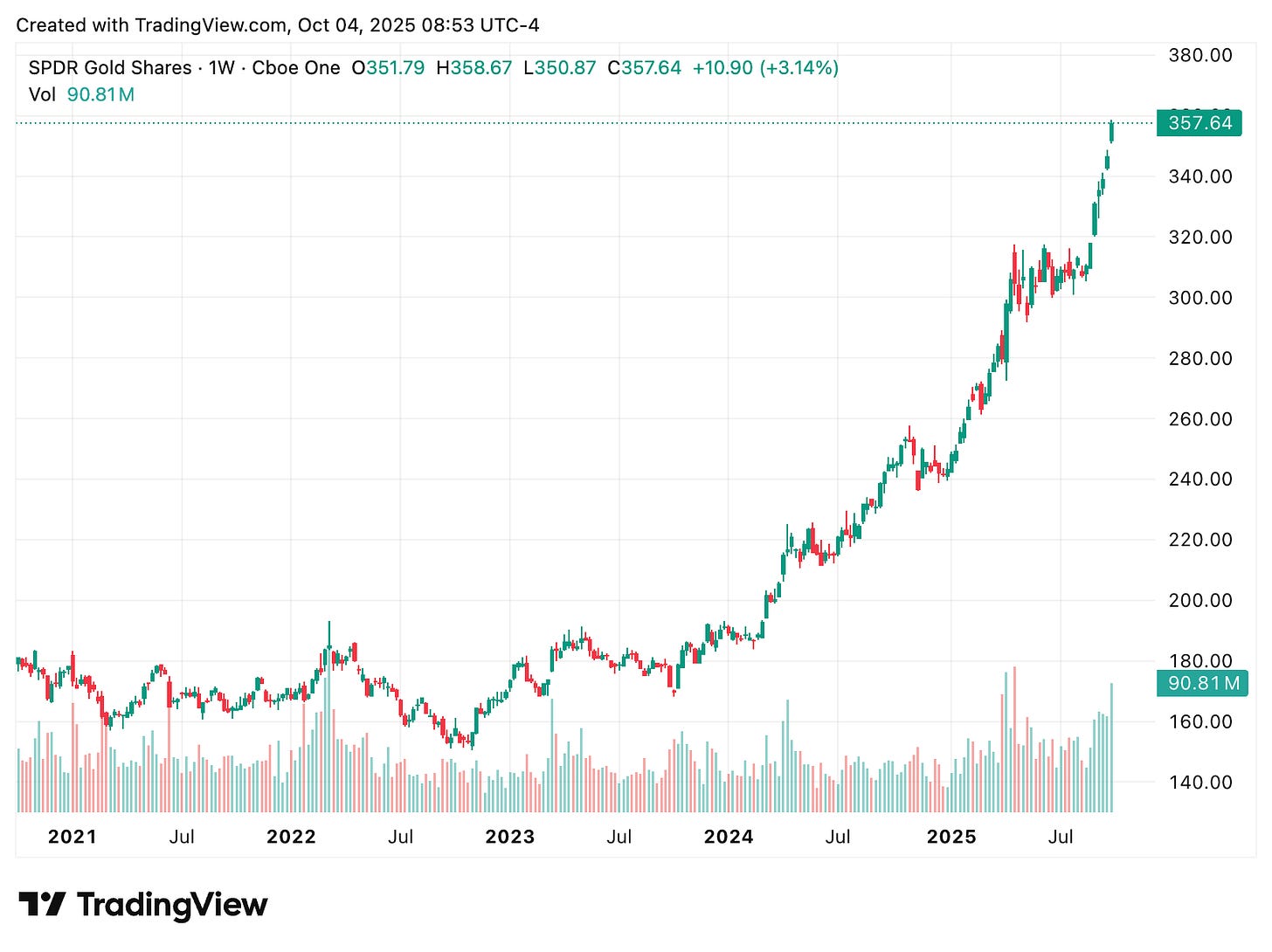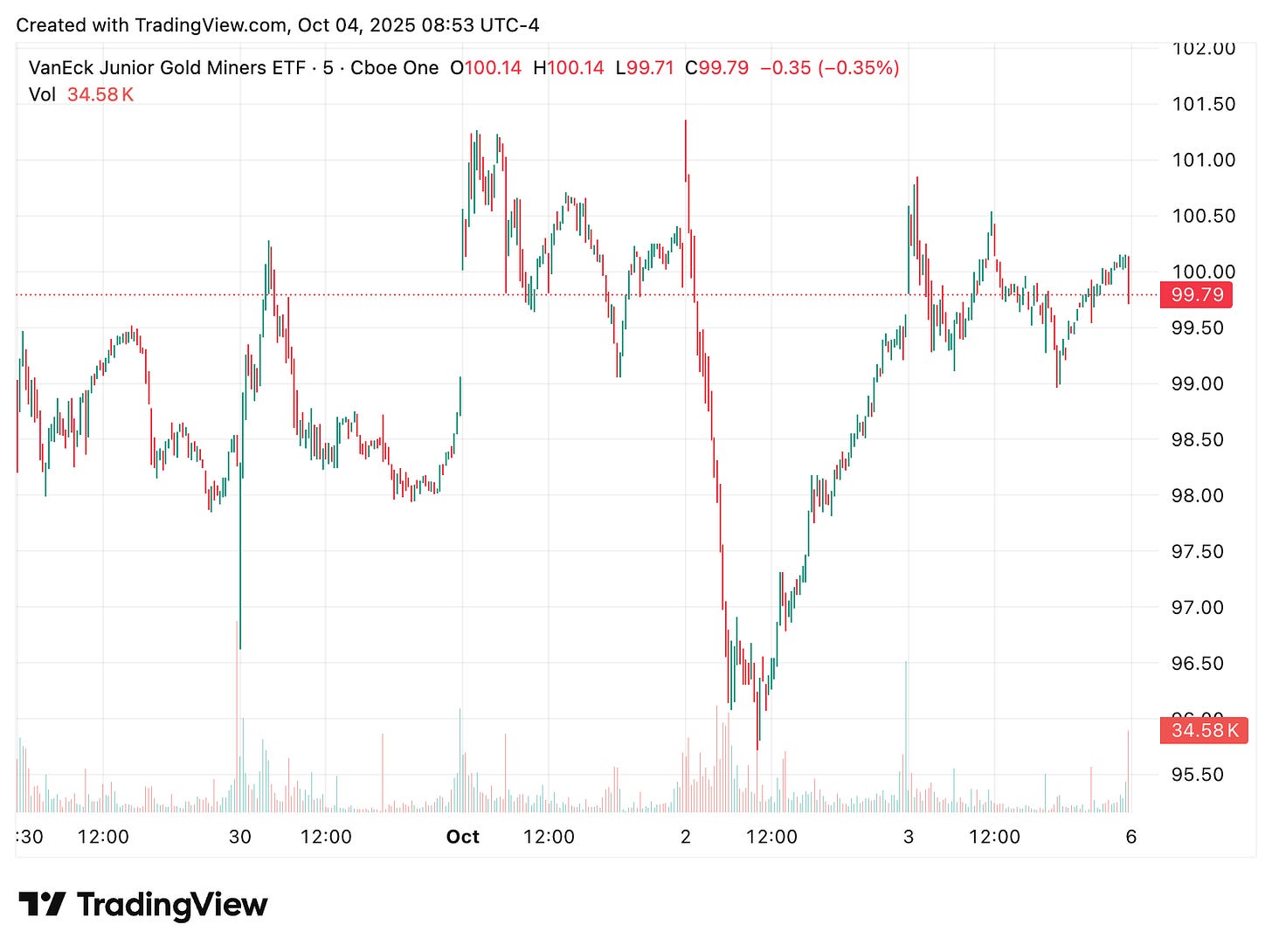The Gold Bull Isn’t a Bubble...Yet...
What Today’s Mania Is Missing
Written by Rebel Capitalist AI | Supervision and Topic Selection by George Gammon | October 4, 2025
Gold just hit a new all-time high, trading near $3,900 per ounce intraday. The headlines are screaming. Twitter is buzzing. But the most important signal is the one you’re not seeing: retail isn’t buying.
That’s right. Despite gold’s parabolic rise, this rally is being driven not by average investors, but by central banks and institutional capital flowing into ETFs.
So is this a top? Is it 2011 all over again? Should you sell everything now before the collapse?
Let’s dig into what’s really driving this rally, what history says about gold tops, and how the smart money is trading it.
Central Banks Are Hoarding Gold
Start with the facts: central banks have purchased over 1,000 metric tons of gold per year since 2022.
That’s not a typo. It’s a multi-year, multi-national push to reduce dollar exposure and diversify reserves.
Why? Simple. Since the West weaponized the dollar post-Ukraine, global central banks no longer see Treasuries as a risk-free asset.
Gold, unlike fiat, has no counterparty risk.
This is especially true for emerging markets. For these nations, the dollar used to represent utility.
Now, it represents geopolitical vulnerability. (This is applicable to the central banks, for commercial banks it’s a much different story. USD utility makes it the only option)
So they’re buying. In bulk. And that’s a key reason gold is climbing…this isn’t speculative FOMO. It’s sovereign risk hedging.
But here’s what almost nobody is talking about: those same central banks hoarding gold are also quietly dumping Treasuries. That’s not diversification…it’s preparation.
The shift away from the dollar isn’t just a hedge…it’s a vote of no confidence.
The next question is, who’s following their lead…and who’s about to get caught on the wrong side of that trade?
Retail Investors Are Still Missing
Remember 2011? That was a true gold mania. You couldn’t turn on a TV or walk through a mall without seeing “We Buy Gold” signs. Every kiosk. Every ad. Your normie friends were bragging about bullion purchases.
Today? Crickets.
In fact, according to the World Gold Council, gold jewelry demand has weakened, especially in key markets like China.
In the first half of 2025, Chinese jewelry demand dropped ~26% by weight year over year.
Meanwhile, bar and coin demand is rising, but still subdued compared to mania levels.
This is crucial. We are seeing a massive price spike without full-scale retail participation. That’s not what a blow-off top looks like.
Until retail piles in…until premiums explode, until normies start asking about $10,000 gold…this isn’t a bubble. Yet.
In other words, the average investor hasn’t even woken up yet. The irony? By the time they do, it’ll already be too late.
Retail always shows up in the final act…the moment the smart money is sneaking out the back door.
The real question is, how much runway is left before Main Street joins the stampede?
ETF Flows Are Driving the Run-Up
So who’s buying? Besides central banks, the biggest inflows are coming from institutional capital via gold ETFs.
When large funds buy GLD or similar products, those funds are required to purchase actual gold to back their shares. That creates significant upward pressure on price, even if retail isn’t involved.

This is what’s driven the most recent leg of the rally…passive institutional buying and sovereign accumulation.
If retail joins the party? Then we could be off to the races.
And if you think the ETF inflows are big now, wait until the algorithms kick in.
Passive allocation models are still underweight gold by historic standards. A small rebalance could unleash billions in automated buying.
That’s when things get parabolic…and that’s when risk management becomes everything.
What the Charts Are Telling Us
Looking at intraday charts of both gold and the GDXJ (Junior Gold Miners ETF), the pattern is unmistakable: any dip is being aggressively bought.
GDXJ briefly dipped below $99 intraday before recovering into the close.

Created with TradingView Gold showed a similar dip-and-recover pattern.

Created with TradingView
This shows extreme buy-the-dip behavior from institutional traders. This is not “dumb money” panic buying. It’s capital deployment on strength.
These kinds of V-shaped recoveries intraday are hallmarks of bull markets still in motion, not bubbles about to pop.
When every dip is being devoured by institutional capital, it tells you one thing: this isn’t greed…it’s conviction.
But conviction can turn into mania faster than anyone expects.
The real tell will come when price action starts to decouple from fundamentals. And that signal may already be forming beneath the surface.
Is This Like 1979–1980?
Maybe…but we’re not there yet.
In the late 1970s, inflation fears drove gold to $850 an ounce (over $3,000 today in real terms). The top came after retail flooded in and the media began predicting gold prices going up forever.

That’s not the environment we’re in yet.
Yes, inflation remains high. Yes, the labor market is deteriorating. But the big difference is positioning. Retail isn’t all-in. Premiums aren’t exploding. Gold commercials aren’t saturating the airwaves.
We may still be in the middle innings of this bull run.
We’re not at the 1980 blow-off… yet. But history never repeats exactly…it rhymes.
The conditions are aligning for a repeat of the late-stage gold bull that turned quiet accumulators into legends.
The only missing ingredient? Retail euphoria. When it arrives, you’ll want to have your exit plan ready.
Why the Fed’s Confused Hawkishness Isn’t Killing Gold
Lori Logan from the Fed made headlines warning about inflation and opposing rate cuts…but the market didn’t care. Gold dipped, then snapped right back.

Why? Because the bond market is starting to price in cuts regardless of Fed rhetoric, driven by:
Crumbling labor data (ADP prints, JOLTS).
Weakness in construction.
Recession signals in small business employment.
The Fed can talk tough. But the market is sniffing out the truth: real rates may need to fall. And that’s bullish for gold.
The Fed’s problem isn’t credibility…it’s reality. They can’t talk inflation down while the bond market screams recession.
When policy loses traction, gold becomes the ultimate protest vote against monetary gaslighting.
And that’s why the next move in gold may not wait for a rate cut…it may front-run it.
Gold Miners Are Finally Catching Up
While gold has surged, miners lagged…until now.
Miners, especially juniors like those in GDXJ, have underperformed for years due to inflationary cost pressures and margin compression.
But now, with gold hitting new highs and input costs stabilizing, their leverage is kicking in.

That’s why George recently reallocated a portion of his physical gold holdings into miners. He bought GDXJ near $68. It’s now near $100. And he’s not done.
If this trend continues, miners could dramatically outperform spot gold…just like they did during the last leg of the 2000s bull run.
Miners are where the asymmetry lives. They’re leveraged plays on a monetary regime that’s quietly breaking down.
And when capital finally floods back into the sector, the gains won’t be linear…they’ll be explosive.
But the window to position early is shrinking fast. The smart money’s already inside.
What Would Make This a Bubble?
We’re not there yet. But here’s what to watch for:
Massive dealer premiums (indicating retail mania).
Normies bragging about buying bullion.
Wall Street Journal or Economist covers predicting $10,000 gold.
Exploding coin sales and ETF inflows.
Until those show up, this remains a fundamentally driven bull market, not a speculative mania.
Does that mean you should buy today? That’s your call. But for those already long, there’s no clear reason to sell yet.
Just remember: the bubble phase comes last. And it’s the most profitable…if you know when to exit.
The bubble phase is where legends are made…and portfolios are destroyed. Knowing when to ride it and when to step off is the difference between wealth and ruin.
And the signals that separate the two aren’t in the headlines…they’re in the flows, spreads, and premiums we track daily inside Rebel Capitalist News Desk.
Trade Ideas: How to Ride the Bull Without Getting Gored
1. Long GDXJ (Junior Miners ETF): Leverage to gold’s upside with added volatility.
2. Long GLD (Gold ETF): Simple exposure for those who want liquidity.
3. Long Physical Gold: Best for safety, security, and no counterparty risk.
4. Watch for Retail Signals: When your friends start asking about gold, start tightening stops.
5. Consider Trimming into Mania: If dealer premiums explode, it may be time to rotate into miners or even cash.
If you’ve been following this gold bull from the sidelines, now’s the time to stop guessing and start understanding the mechanics behind the move.
Every week, George Gammon breaks down these macro shifts in his premium wrap-up videos and exclusive whiteboard sessions…showing exactly how the data ties into tradeable trends.
The Gathering Storm (Weekly Wrap-Up 10/3/25)
Imagine waking up to a world where the job market’s “strong” facade crumbles overnight, revealing a shaky foundation that could drag the entire economy into recession.
👉 Upgrade to a paid Rebel Capitalist News Desk subscription to unlock those insights, access full weekly reports, and join thousands of liberty-minded investors who refuse to get blindsided by the next phase of this cycle.
Because when the bubble phase hits, it won’t be the headlines that save you…it’ll be your preparation.








Retail buyers are nothing compared to the passive bid, which in reality is retail buyers.
Thanks for this article. Where can one monitor the "dealer premiums" that herald retail involvement?